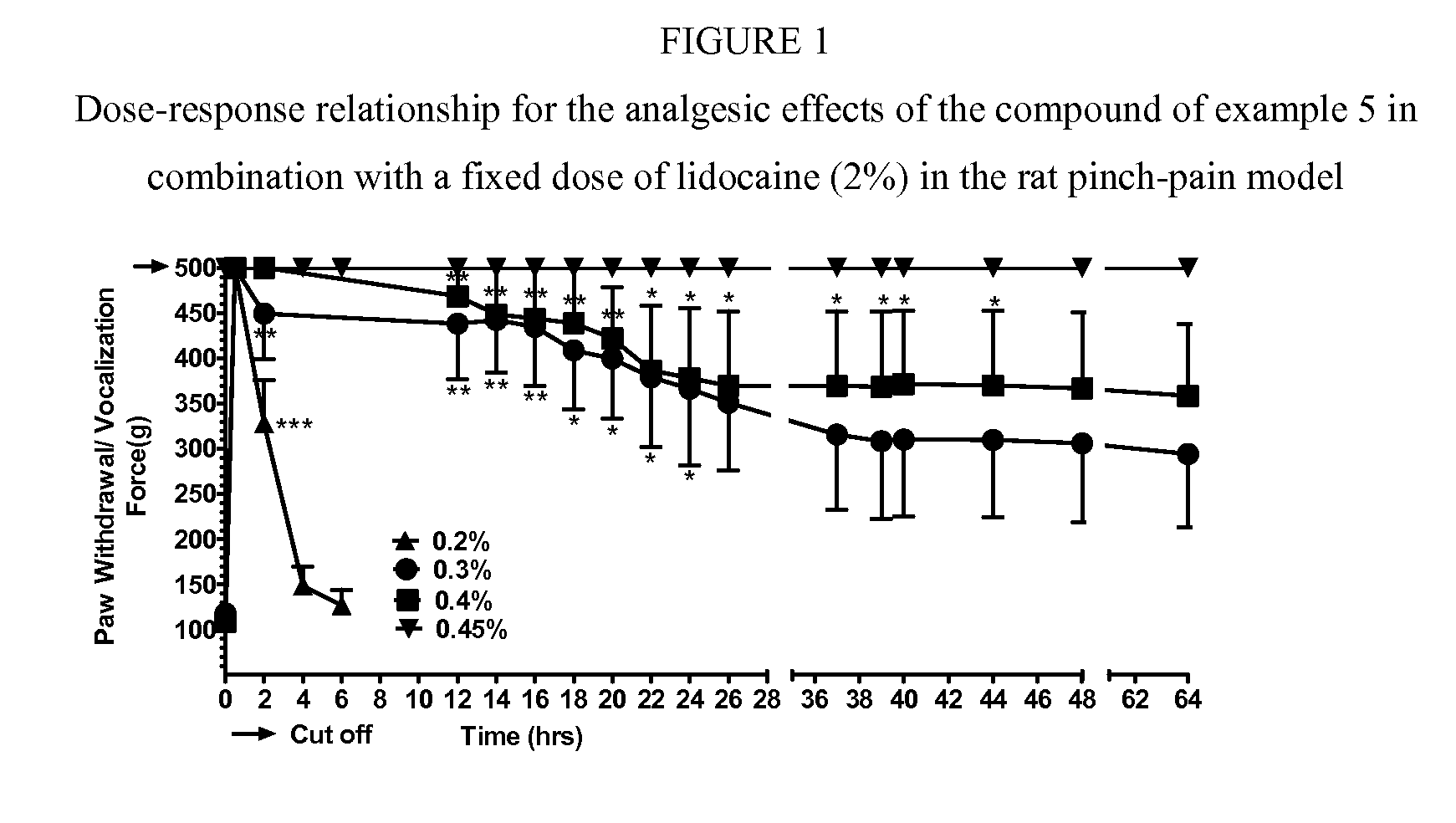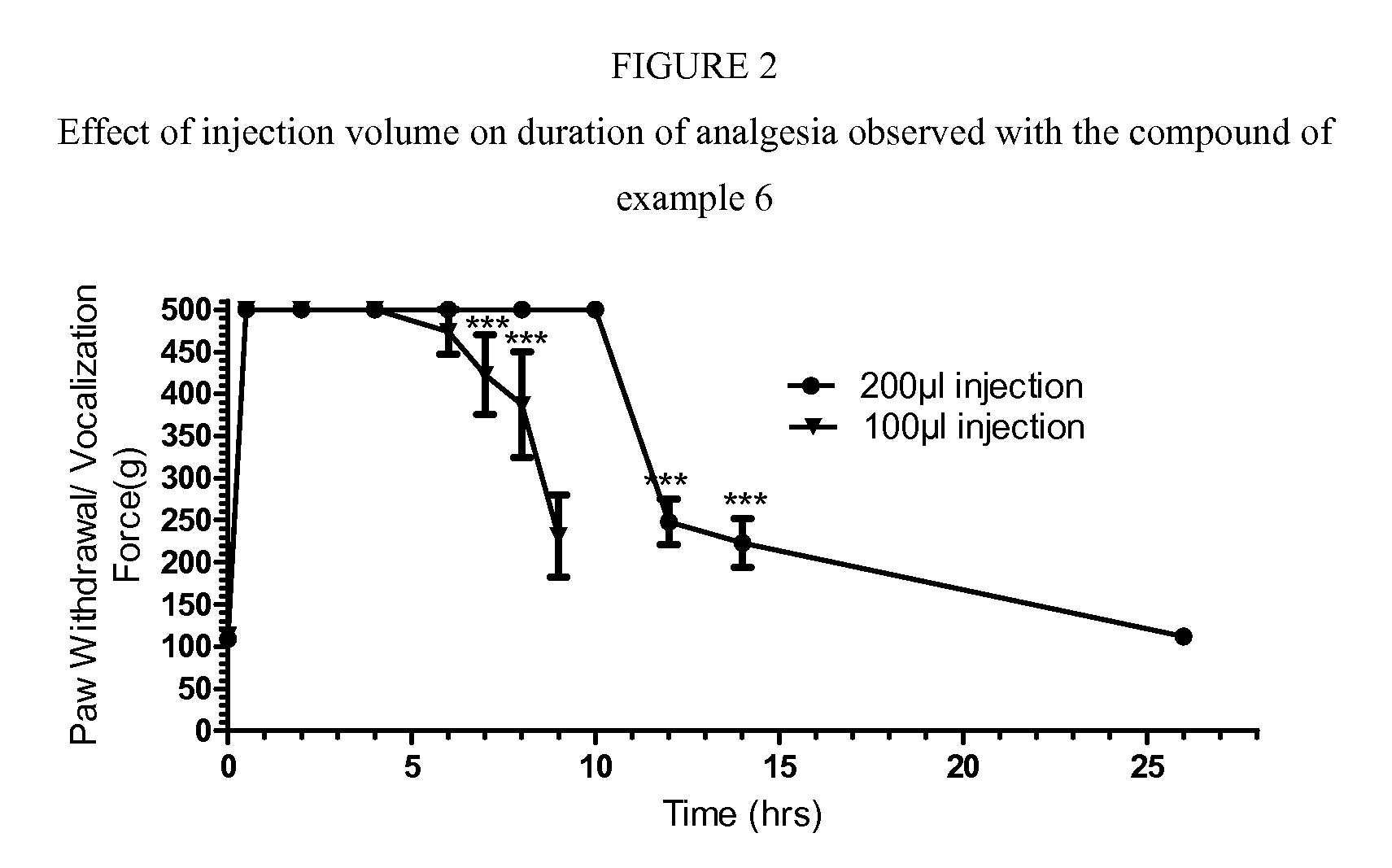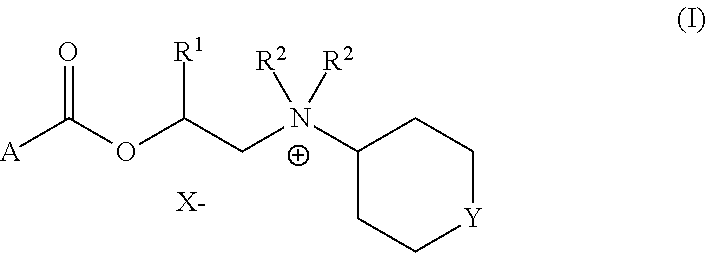Cyclohexylamines
a technology of cyclohexylamine and cyclohexylamine, which is applied in the field of cyclohexylamines, can solve the problems of unfavorable motor function withdrawal, lidocaine nor mexilitine offer therapeutically tractable options,
- Summary
- Abstract
- Description
- Claims
- Application Information
AI Technical Summary
Problems solved by technology
Method used
Image
Examples
example 1
General Procedure A—Preparation of N,N-dimethyl-N-[2-((2,4,6-trimethylbenzoyl)oxy)propyl]cyclohexanaminium iodide
[0232]
I: 1-(Cyclohexylamino)propan-2-ol
[0233]To a solution of 1-amino-2-propanol (15 g, 0.199 mol) in ethanol (300 ml) was added cyclohexanone (31.4 mL, 0.299 mol). The reaction mixture was stirred at 0-10° C. for 10 minutes. Sodium borohydride (10.8 g, 0.285 mol) was added at 0° C., then stirred at rt for 15 minutes. The resultant reaction mixture was quenched with water, filtered through the Celite® reagent, and solvent was evaporated. The residue was dissolved in 2N HCl, washed with ethyl acetate; the pH of the aqueous layer was adjusted to 8 using saturated sodium bicarbonate solution. The compound was extracted with ethyl acetate. The organic layer was dried over sodium sulphate, concentrated to dryness, and the crude material was subjected to column chromatography to obtain 1-(cyclohexylamino)propan-2-ol. Yield: 22 g (70.1%); 1H NMR (400 MHz, DMSO-d6) δ 8.25 (bs, 1 ...
example 2
General Procedure B—Preparation of N-[2-((2-isopropylbenzoyl)oxy)propyl]-N,N-dimethylcyclohexanaminium iodide
[0238]
I. 1-(Cyclohexylamino)propan-2-ol (1)
[0239]To a stirred solution of 1-amino-2-propanol (1.0 mL, 13.31 mmol) in ethanol (15 mL) was added cyclohexanone (1.9 g, 19.9 mmol) at 0° C. The reaction mixture was stirred at 0° C. for 15 minutes and then NaBH4 (0.725 g, 19.17 mmol) was added. The reaction mixture was stirred at rt for 15 minutes and then quenched with water. The reaction mixture was filtered through a Celite® pad and the filtrate was concentrated. The residue was dissolved in DCM, dried over Na2SO4, filtered and concentrated to provide 1-(cyclohexylamino)propan-2-ol. Yield: 2.6 g (crude). 1H NMR (DMSO-d6) δ 4.39-4.36 (m, 1 H), 3.61-3.57 (m, 1 H), 2.47-2.30 (m, 3 H), 1.78-1.75 (m, 2 H), 1.66-1.63 (m, 2 H), 1.55-1.52 (m, 1 H), 1.23-1.12 (m, 3 H), 1.03-0.89 (m, 5 H). 1-(cyclohexylamino)propan-2-ol may also be prepared by following procedure of Example 1.
II. 1-(Cyclo...
example 3
General Procedure C—Preparation of N-[2-(benzoyloxy)propyl]-N,N-diethylcyclohexanaminium chloride
[0243]
I. 1-(Cyclohexyhethyl)amino)propan-2-yl benzoate (17)
[0244]To a stirred solution of benzoic acid 2-cyclohexylamino-1-methyl-ethyl ester (1.0 g, 3.8 mmol) in DCE (20 mL) were added successively K2CO3 (2.11 g, 15.2 mmol) and ethyl iodide (1.8 mL, 22 mmol). The resulting mixture was heated at 50° C. for 16 hours in a sealed tube. Ethyl iodide (1.8 mL) was again added and the reaction mixture heated at 60° C. for another 24 hours. The reaction mixture was filtered and washed 5% methanol-DCM. The filtrate was concentrated and the crude material was purified by Combiflash® chromatography eluting with 6-7% methanol / DCM to provide 1-(cyclohexyl(ethyl)amino)propan-2-yl benzoate. Yield: 1.04 g (94.70%). 1H NMR (DMSO-d6) δ 7.95 (d, J=7 Hz, 2 H), 7.64 (t, J=7 Hz, 1 H), 7.52 (t, J=8 Hz, 2 H), 5.08-5.04 (m, 1 H), 2.68-2.62 (m, 1 H), 2.55-2.40 (m, 4 H), 1.70-1.53 (m, 5 H), 1.26 (d, J=6 Hz, 3 H), ...
PUM
| Property | Measurement | Unit |
|---|---|---|
| wear time | aaaaa | aaaaa |
| wear time | aaaaa | aaaaa |
| temperature | aaaaa | aaaaa |
Abstract
Description
Claims
Application Information
 Login to View More
Login to View More - R&D
- Intellectual Property
- Life Sciences
- Materials
- Tech Scout
- Unparalleled Data Quality
- Higher Quality Content
- 60% Fewer Hallucinations
Browse by: Latest US Patents, China's latest patents, Technical Efficacy Thesaurus, Application Domain, Technology Topic, Popular Technical Reports.
© 2025 PatSnap. All rights reserved.Legal|Privacy policy|Modern Slavery Act Transparency Statement|Sitemap|About US| Contact US: help@patsnap.com



